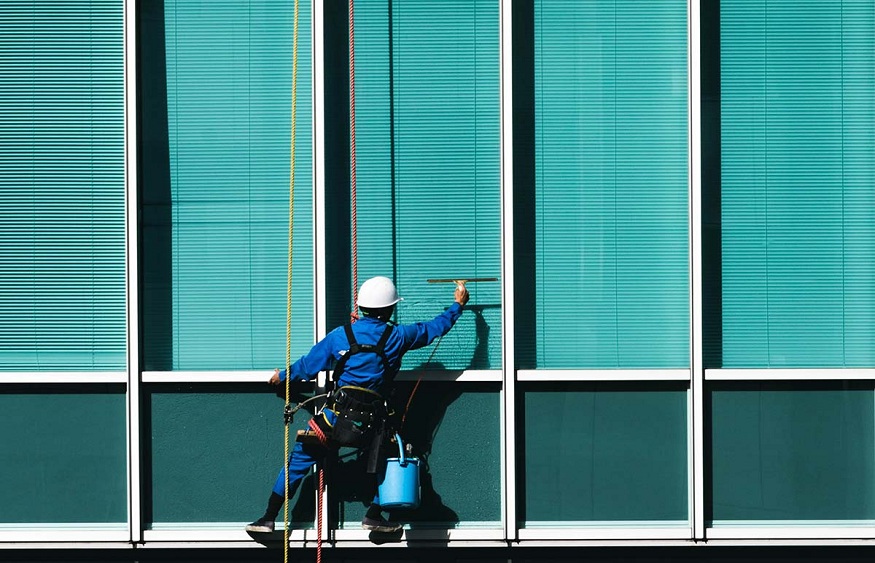Are we to ensure cleanliness only from the inside of the building and not from the outside? Does the client simply teleport to your boss’ cabin rather than walking in through the main entrance and lobby of your office?
We can conclude that corporate culture has given more importance to this practice than other players in the economy. Public places maintained by the government or local ownership cannot surpass the lustre that the exterior of any business firm has.
Commercial environments are devoted, especially to the cause of attracting new deals and better customers to keep their business growing. This often pushes the management to think along the lines of selling their business, even before the company representatives have sat down for serious negotiations.
Workplace sanitation is more of a public display than a concern for business heads. This holds even more relevance for cleaning the exterior of the building, which we term facade cleaning. Naturally, the outer appearance is what crosses the eyes of any visitors. Maintaining it hence becomes a tough job because it must be carried out at regular intervals of time and performed by experts using the best available equipment.
We can’t emphasise more how important it is for you to make your guest feel comfortable and welcomed on your premises. A commercial hub like Dubai needs more rigorous facade maintenance given its rough geography and extreme climate. Office sites here have to routinely bear the limits of temperature, humidity and dust storms. These factors not only remove the shine of high-rise glass or metal-outlined skyscrapers but also degrade the material that remains the most exposed on the outside. Therefore, it is important to choose the best techniques that help in giving the perfect look to your facade.
Moving forward, it first depends on the kind of masonry used to construct the building. The material on the outside determines what methods you employ to clean it. Today, buildings are being constructed with a range of resources such as glass, stone, wood or even layers of metal. Identifying the sensitive spots in your facade is also a way that the professionals suggest doing. After all, facade cleaning is a serious affair which demands funds, and time and also carries the risk of damaging the infrastructure if incorrect cleaning substances are employed.
The market for facade cleaning offers a number of popular options that one could look for. Broadly, water, chemical and abrasive treatments are the ones most used on a large scale.
Water Treatments:
These are the most basic forms of facade cleansing activities, wherein the goal is to get rid of ordinary dust, sand, suspended matter, and grime. These are also the most gentle ways of cleaning any usual surface at the minimum possible expenditure.
Water techniques take multiple forms as per the requirements. Among those, pressure washing is the most commonly used. This method follows the traditional approach of using a spray or a hose of water, which runs on both low and medium pressures (110 psi – 350 psi). Water is systematically sprayed over pre-demarcated areas occasionally accompanied by bristle scrubs for the spots harder to clean.
The Soaking technique is only a repetitive use of the pressure-washing method. This low-cost but effective measure aims to drench the grime and soot for extended periods of time to rinse them off using regular brushing afterwards.
Buildings that are built using sensitive material like stone sometimes uses the steam bathing method. This technique helps in extracting dirt and deposits from unreachable spots in the structure.
In some water treatments, specially manufactured detergent agents are mixed in water storage tanks, that help to take out the oil and grease which accumulates on the facade surface.
Chemical Treatments:
Facade maintenance sometimes gets tricky given the instances of facade staining and physical damage caused by indiscriminate chemical use. Chemical treatments are capable of removing the impurities on which water does not work. These include chemical paints, heavy metallic marks, rust, effects of acid rain and also permanent coatings.
Chemical treatments are both acidic and alkaline, based on the top layer of the facade. Usually, granites, sandstones and iron are easily cleaned using acid-based cleansers. For sensitive surfaces like marbles or limestones, which get stained without effort, it is important to use tolerable solutions such as alkaline-based cleansers.
The down point of the chemical treatment lies in the fact that though it might look like the most efficient way to get done with facade cleaning, it is also the easiest way of permanently damaging it, to the extent that a complete section of the facade is rendered useless. Chemical agents are allowed to remain on the applied surfaces. They are finally washed off using water, like in the pressure washing technique.
Abrasive Treatment:
This is a rather old-style way of scraping dirt or other impurities from surfaces. Methods like sanding or grinding facades, usually take off the top material, if performed in an amateur way. This technique is suggested and sometimes recommended for personal/ domestic use, though it is not commercially viable.
Still, on some occasions, commercial facade maintenance makes use of abrasive techniques, coupling them with the use of water and chemicals.
Warm climates like that of Dubai, are recommended to be used for cleaning facades. It is because both the better alternatives, water and chemicals, show better results.
Preparing your facade for cleaning requires thorough ideation. The facades must be repaired before the cleaning happens. If they’re not, then the cleaning will not get the best outcomes for the establishment.
Lastly, an important technique that complements the methods given above is testing patches of facades. This also ensures that the chemical solutions and water pressure are carefully re-checked to avoid any mishappenings.





